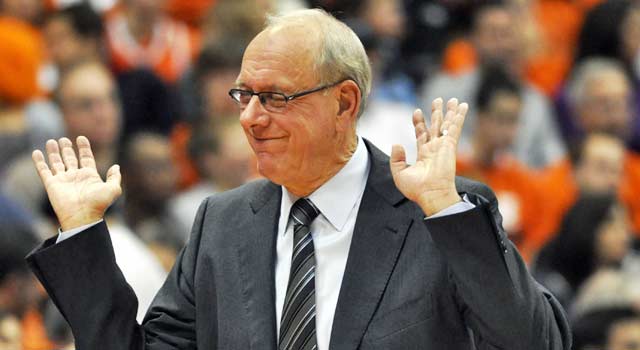One of the central emergent themes in this college basketball season — one which will continue to merit attention in the coming weeks — is that a lot of big-name programs are in trouble relative to making the NCAA tournament.
The two teams that played in the first national semifinal at last year’s Final Four, Florida and Connecticut, are already toasted as at-large candidates. They’ll have to win their conference tournaments to make the field. UCLA, a four seed last year, has to run the table or something close to it — beating Utah this week and Arizona later in the season — if it wants to have any shot at an at-large bid. Those chances are slim to none right now. Injury-riddled Michigan is almost certainly an NIT team. On Sunday, we looked at the fragile situation faced by Michigan State and Tom Izzo.
There’s another brand-name basketball school which is fighting for its NCAA tournament life right now, and that’s the team we’ll look at today.
*
The Syracuse Orange were unbeaten in late February of 2014. The Orange seemed like a lock for a top seed, their second in three seasons and their third in five seasons. Jim Boeheim had really seemed to be turning the corner in terms of getting the most out of his teams during the regular season. Then, however, everything fell apart. A late-season swoon influenced by injuries took the Cuse to a No. 3 seed. The magical run of the Dayton Flyers ended Syracuse’s season in the round of 32. The optimism drained from the Orange program.
A year later, this is still a team in search of something that’s missing.
Syracuse is very much on the fence as far as NCAA worthiness is concerned. The Orange defeated Iowa out of conference and played a tough schedule that will improve their RPI relative to other teams that weren’t as ambitious. However, Syracuse lost to Cal — a result that’s going to continue to weigh down this team’s profile in the coming weeks. The Orange also failed to win any of three games against Michigan, St. John’s, and Villanova. Just one win in those three games would have helped offset the Cal loss, but an 0-3 mark is bad news.
In ACC play, Syracuse hasn’t yet picked up a scalp of appreciable value. The Orange have been good (though not perfect) in avoiding bad losses, stumbling only at Clemson while beating the other lesser lights in the conference. However, following a home loss to NCAA-bound Miami on Saturday, the Cuse is not in the NCAA tournament house (oh my God, oh my God). The Orange won’t attain that safe shelter until they can notch a few quality wins. This is why tonight’s game at North Carolina is so important. It’s also why Syracuse fans are legitimately scared about the road ahead.
From Feb. 14 through the rest of the regular season, here is Syracuse’s schedule:
Duke, Louisville, Pittsburgh, at Notre Dame, at Duke, Virginia, at North Carolina State.
The Orange might gulp on their pulp in response to that Murderer’s Row, but this team has little choice but to prepare for that gauntlet. Let’s say Syracuse beats Pitt and loses at N.C. State. Should that scenario occur, the Orange would need to win two of the other five games (Duke twice, Louisville, Notre Dame, Virginia) to feel at least somewhat safe about cracking Bracketville. A 1-4 mark would probably mean Syracuse would have to win at least a game at the ACC tournament, possibly two. An 0-5 mark would mean the Orange would have to make the ACC tournament final (and by beating good teams, not lower-seeded teams that are the products of upsets) to alleviate some sweat and stress on Selection Sunday.
What becomes very worrisome for Syracuse is that this team — as presently constructed, and in light of its current form — is not ready to handle that aforementioned stretch of games against the upper tier of the ACC.
Coach Jim Boeheim shortened his rotation to just six players Saturday against Miami. His team competed hard, but with four players going all 40 minutes, the Orange — even with their leg-saving 2-3 zone — faced a small margin for error, one that was unable to withstand a poor performance at the free throw line (8-of-19).
The fact of the matter is that Syracuse gets far too little production from players not named Rakeem Christmas (and to a lesser extent, Trevor Cooney). The 2010 Syracuse team could spread the floor and get production from multiple knockdown shooters. The 2013 Final Four team used James Southerland’s shooting to space the floor for slashers such as C.J. Fair, who could find seams in opposing defenses. Cooney is a capable shooter, but he is smaller than Southerland and is therefore less able to shoot over the top of defenders. He has a hard time creating his own shot, which makes it essential for the team to have a dynamic point guard. Kaleb Joseph is simply not that player yet. He’s struggled far too often in ACC play, and that’s the foremost thing which has to change for Syracuse in the weeks ahead. This team needs more balance to, in turn, become less predictable on offense. Improving at the foul line goes without saying; what Syracuse has to have is a point guard who can change the dynamics of a game for the better, not for worse.
If the Orange don’t get the production they acutely need in the very near future, an NIT trip beckons, which is about the last thing you would have expected 12 months ago from this program.

